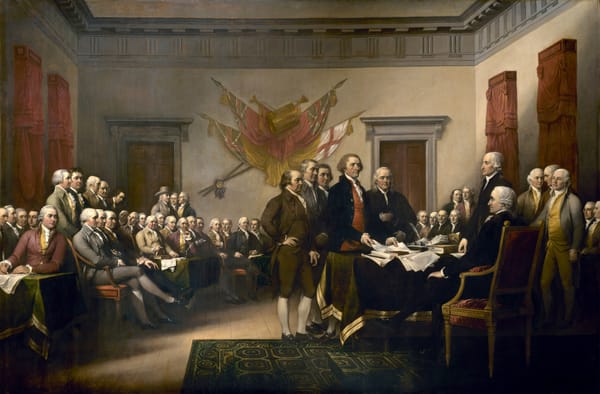Turning Back Alienation Without Turning Back the Clock

Are you lonely tonight? Or do you have a sense that many in your community are lonely? If so, then Timothy P. Carney has written a book about you. Alienated America describes a breakdown in American civil society, what this breakdown means, and why it has happened.
The collapse of civil society is not a new phenomenon and Carney* is not the first to notice it. Carney builds on previous work by Charles Murray, Yuval Levin, and Robert Putnam stretching back to the mid-90s. “Civil society” can mean many things, but, Carney explains, “the simple way of asking about ‘civil society’ or ‘associational life’ is this: Do you do stuff with other people?” And increasingly, in America, the answer is no. Americans are “less socially connected and experiencing more loneliness,” and experience “isolation regularly,” according to psychologist Julianne Holt-Lunstad, quoted by Carney. Where are the little leagues, the country clubs, the neighborhood associations? And most importantly for Carney, where are the churches and where are the marriages? Stuck somewhere in the ’60s, blocked by godless modernity and the Democratic Party.
Why care that people spend more time alone? Maybe Americans just don’t want to hang out with each other as much anymore. I mean, have you met other people? Awful. And besides, these days there’s so much great stuff to do alone, like reading this article. Maybe what seems like alienation is really just progress.
Carney offers three harms that come from alienation:
First, alienation is associated with increased deaths by suicide and overdose, increased out-of-wedlock births and decreased social mobility. “[T]he story of rising suicides and crumbling families, and the story of growing inequality and falling economic mobility,” argues Carney, “is properly understood as the story of the dissolution of civil society.”
Second, community bonds do not just foster the good life, they are the good life. It’s not just that loneliness can lead to suicide and addiction, which are bad. The prevalence of suicide and addiction among the lonely is evidence that loneliness is itself bad. It is a way that lonely people are expressing their dissatisfaction with their life. By contrast, people engaged with society are happy, not only because that engagement can lead to income and good health, but because the engagement itself provides joy. As Carney writes, “[t]he materialistic view of the American Dream(…)misses the point(…)maybe the things we think accompany the American Dream really are the American Dream. What if the T-ball game, the standing-room-only high school Christmas concert, the parish potluck, and decorating the community hall for a wedding—what if those actives are not the dressings around the American Dream, but what if they are the American Dream?”
Third—and this is Carney’s big pitch to liberals—alienation gave us Trump. Carney agrees with many liberals that Trump voters aren’t driven by “economic anxiety.” But it’s not that these voters have chosen to reject social progress; instead, their community institutions have deteriorated and left them isolated. In “tight-knit religious communities,” even if the community isn’t wealthy, it is strong. These places rejected Trump, at least in the primaries. But where the pews were empty, the Trump rallies were full. So take your pick, libs. You can burn down the churches, but it will be Trumpism, not your secular liberal paradise, that arises phoenix-like from the ashes.
Carney allows the possibility of community without religion, but only for elites. Though elites are more religious than they let on (among whites, church attendance and income are positively correlated), they are largely held together by secular community institutions—the various community committees that look after parks, preservation, seniors, events, and so on. Carney profiles Chevy Chase, Maryland as an example of such a community.
The trouble is that elites are by definition few in number, so this path is a narrow one. For those elbowed out of the elite communities, the most viable source of community cohesion is religion. For these people, the decline in religiosity has meant a decline in community strength. “The unchurching of America is at the root of America’s economic and social problems,” Carney writes.
How narrow is the elite path?
I’m not quite convinced the alienation necessarily results in Trump. Trump has never been very popular. Had the Republican field narrowed sooner, perhaps an anti-Trump coalition would have carried the GOP primary. Hillary won the popular vote; had either Barack or Michelle Obama been a candidate I am confident Trump would have lost in a landslide. Nor am I convinced that community immunizes against Trump. Trump is now wildly popular with evangelical voters. Carney dismisses this as pure partisanship, focusing instead on the determinants of Trump support in the primary.
But leave Trump aside for the moment. Let’s agree with Carney that community is important, and at the moment much of America suffers from too little of it. Does it follow that the problem is a lack of church?
I think not. Carney documents the fall in religiosity in America since the 1960s. His narrative gives the impression that religiosity was high throughout American history, until it started falling in the 1960s, eventually reaching the anomalous lows of today. But as is so often the case with comparisons to the ’60s, it is then, not now, that is the anomaly. Church membership (important for Carney’s narrative, since it is an attachment to an institution) today is still much higher than it was through the 19th century. According to historian Kevin Kruse’s book One Nation Under God, membership “slowly increased from just 16 percent in 1850 to 36 percent in 1900…. In the decade and a half after the Second World War, however, the percentage of Americans who belonged to a church or synagogue suddenly soared, reaching 57 percent in 1950 and then peaking at 69 percent at the end of the decade, an all-time high.”
Church attendance tells a similar story. Carney laments that “in seven short years, attendance fell by a tenth, from about 40 percent in 2007 to about 36 percent in 2014.” But in 1940, it was 37 percent. Attendance peaked at 49 percent in the ’50s, got down to 40 percent around 1970 and has been bouncing around near 40 percent ever since.
The ’50s and early ’60s were an anomaly, not our last glimpse of Eden. If the alienation crisis is only a matter of irreligiosity, it is one we have faced for most of our history, so perhaps it is not much to be worried about. Carney claims that religion is down because of lawsuits that have supposedly been terrorizing religious people over the last decade, and because of the expansion of the welfare state in the ‘60s under LBJ, which Carney argues made superfluous the social insurance function of religious institutions. But the decline well predates the lawsuits he cites, many of which were unsuccessful, and the peak piety of the ‘50s came immediately after the massive expansion of the federal government and the welfare state during the New Deal and WWII.
Even if the ’50s and early ’60s were anomalous, maybe they were a Golden Age, one we would like to recreate, minus the racial segregation, the McCarthyism, and the World Series dominance of the New York Yankees. Must that mean more church? Must it be that, as Carney writes, “in America, among the non-wealthy at least, civil society mostly means ‘church’”? Or can we recreate healthy mid-century communities without relying on religion?
As I mentioned above, Carney allows that “some perfectly secular places have strong community ties and intense civic involvement.” The trouble is that “[t]hey tend to be the wealthy and highly educated places.” Most people can’t afford access to these elite communities. “Joining the elite,” writes Carney, “isn’t something available to everyone. It never has been. Joining a church, on the other hand, has much lower barriers to entry.”
But communities need not be elite in every respect to be un-alienated. They need not be wealthy and highly educated, as long as they can build strong ties through neighborhood associations and all the other secular institutions that Chevy Chase has. Do those institutions require wealth and education of the kind that only a select few in any society could acquire?
Carney sketches an argument that fallen humans need support and structure from religious institutions to live a moral life. While the highly educated may have enough self-control not to need these guardrails, this argument goes, the working class needs firmer guidance. I doubt the elite deserve that much credit nor the working class that little. I also doubt that guidance needs to be godly to be firm. It could be that the working class doesn’t have time for secular institutions—it takes time to organize and attend PTA meetings or the community speaker series or the neighborhood park cleanup, and wealthy people often have more free time. But religious duties and their attendant community obligations take time too. The issue is that more people these days would rather spend that time at home. Maybe they’ll get out of the house to go to the local weekly speaker series just as easily as to go to their weekly religious services.
How do we make America married again?
If there’s anything that troubles Carney more than the collapse of religious institutions, it is the collapse of marriage among the poor and the working class. Here, too, the ’50s were something of an anomaly, with the wedding boom around WWII resulting in a high proportion of people being married in 1960. But it’s still true that Americans marry later than in earlier eras, that marriage is increasingly something only wealthy people do, and that out-of-wedlock births are alarmingly common, particularly among less educated Americans—58 percent of all babies born to women with no college are born out of wedlock; among women with some college but no degree, the number is 44 percent.
For Carney, men don’t marry anymore because they have become shiftless and dissolute. Their lives are no longer disciplined by the values of the community, the rigor of a work schedule, or the threatened damnation of their religion. Times were different back when factory jobs were readily available to teach men responsibility and sacrifice:
[General Electric] needed a man who would show up on time, wait till the whistle to take lunch, call in when he wasn’t going to show up, tolerate hours of the unpleasant, and largely do as he was told…. These skills of the unskilled factory job are the skills of marriage and fatherhood.
If you want to get men excited about marriage again, keep them as far away as possible from this passage. “It’s like a crappy job, but at home and for the rest of your life” is not an appealing sales pitch.
But maybe it’s true that men learn to be obedient worker drones on the job, which in turn makes them obedient husbands. Carney’s argument is that men who would previously have had “reliable factory jobs” today have “irregular and even unreliable work—contractor jobs, occasional gigs…. They reflect more of an on-again, off-again relationship of convenience than a marriage, and perhaps they cultivate other habits: detachment, the default stance of constantly looking for a better deal, and a survival instinct that elevates self-preservation over loyalty.”
There are a couple of problems with this story. One is that the “Gig Economy” is not so large as Carney suggests. “The growth of contingent work,” he writes, “could account for the entire growth of the job market from 2005 to 2015.” But there are many kinds of job growth that, if all other kinds of job growth were held constant, could account for the entire growth of the job market from 2005 to 2015. And even by the estimate Carney cites, “alternative work arrangements” amounted to only 16 percent of all U.S. workers in 2015. More importantly, the authors of that study, Lawrence Katz and Alan Krueger, came out with a new study in January 2019, based on the Bureau of Labor Statistics’s 2017 Contingent Worker Supplement. The BLS survey found that only 3.8 percent of U.S. workers held contingent jobs. Accordingly, the newer Katz and Krueger study claims only a “modest upward trend” in alternative work arrangements.
Another problem is that Americans today are, if anything, less transient than in decades past. As Tyler Cowen writes in his book The Complacent Class, “Americans have become much less restless in movements across the country, and more people are looking to simply settle down and entrench themselves.” More from Cowen, whose book was published between the first and second Katz and Kreuger papers: “One big reason for the decline in residential moving stems from a decline in job switching…. Among the most written-about job phenomena these days is that of the flexible gig economy, as reflected in individuals who work as Uber drivers, for example. That is indeed a significant change in transportation for many of us, but it is not the major trend in the labor market as a whole. Nor has globalization turned all jobs into temporary or transient posts. The data show that job transitions are down and individuals are more likely to spend a long time with a single employer than ever before.”
So it’s probably not the changing nature of work that has weakened marriage. Later, Carney suggests another culprit: “the liberation of sex from marriage and family formation.” Since men in this enlightened age have greater access to casual sex, there is less incentive for them to marry. Whereas accidental pregnancies used to lead to shotgun marriages, today they lead to out-of-wedlock births. Since “college-educated women with high-income college-educated parents are less likely to botch their contraceptive use,” they are insulated from this problem. But “working-class and poor women,” writes Carney, “take their cues from culture that tells them sex and family are separate” while “in their own lives, sex is more likely to yield babies, thanks to imperfect use of contraception. The result is broken families.”
As in his analysis of civil society, Carney describes two paths to success: a modern path for heathen elites, and an old-fashioned path for pious plebs. And again, Carney lacks either the imagination or the inclination to consider that there’s plenty of room on the elite path for everyone. There’s no iron law that says non-elites can’t figure out how to use contraceptives and, if contraceptives fail, follow elites in aborting a high percentage of out-of-wedlock births. Carney, an ardent opponent of abortion, may find that as repulsive as secularists find his promotion of religion revanchist. Nevertheless, it works. Instead of reversing the sexual revolution, which would likely prove impossible even if it were desirable, the easier and more generous response would be to open the elite path to everyone. Indeed this is the conclusion of George Akerlof and Janet Yellen’s 1996 Brookings paper, which Carney cites extensively:
With sexual abstinence rare and the stigma of out-of-wedlock motherhood small, denying women access to abortion and contraception would probably increase the number of children born out of wedlock and reared in impoverished single-parent families. On the contrary, efforts should be made to ensure that women can use the new technologies if they choose to do so.
Indeed the unmarried birth rate seems to have peaked in 2009. Since then, the birth rate for unmarried women has fallen sharply in the United States, especially among women under 29 years old. Whether this has anything to do with the Affordable Care Act’s contraception mandate, which took effect in August 2012, would require more rigorous analysis than simply looking at a trend line. The trend seems at least as strong in the three years before 2012 as afterwards, so possibly the contraception mandate hasn’t helped. In any case, it seems the unmarried birth rate is moving in the right direction, and at the very least increased access to contraception hasn’t gotten in the way. With universal access to birth control, perhaps everyone can follow elites in delaying childbirth, but not sex, until after marriage.
Who is avoiding whom?
But Carney is onto something important, I think. People do have a weaker sense of community these days, and do spend more time alone, detached from society with fewer ways to participate in it. And elites are, in part, responsible. It’s not so much that they’ve offered an infeasible model for the rest of society—it’s that they’ve withdrawn from general society into their own elite bubble. As Carney documents, elites are increasingly a segregated world unto themselves. They marry other elites, live near other elites, work with other elites. Their children go to school with the children of other elites. They meet the “working class” only through Pulitzer-bait profiles in the Washington Post.
This withdrawal of the elites robs the working class of institutional leaders. “The elite neighborhoods,” Carney writes, “have plucked the would-be PTA presidents, the would-be small-town mayors, and the would-be leading local businessmen from hundreds of small towns and suburban and rural counties around America and jammed them into a few towns near Long Island Sound or a few blocks on either side of Connecticut Avenue.” This is almost right. Cities have always drawn the most ambitious and talented young people from small towns around the country. What’s changed, as David Autor demonstrates in his 2019 Ely Lecture, is that people are no longer moving back to less urban areas between ages 25 and 39. “We knew,” says Autor, “that young adults were moving towards cities, but they were also moving back again as they reach family raising age. And they’re doing less of that than they used to.”
Fixing this self-segregation is a policy challenge. It’s probably easier to integrate by getting more working-class people to move nearer to elites than the other way around. Relaxation of the local zoning rules that the wealthy use to insulate themselves would help. But Autor shows in the same lecture linked above that working-class jobs are less available in cities than in previous decades.
Perhaps elites just need a culture change. They should engage more with the lower classes, through volunteer work, more broadly-based institutions, and so on. Through their churches, sure, but also through the T-ball team. They should lobby their school boards to draw districts to be less segregated. They shouldn’t oppose construction of denser, more affordable housing in their neighborhoods. But it’s not obvious how to get elites to do these things when they benefit so greatly on an individual level from exclusive, valuable networks.
So are Trump voters simply the victims of elite withdrawal? I don’t think that’s the entire story. As Carney writes, “Trump did well among individuals who seemed to be doing okay except that they lived in places that were very much not doing okay.” That is, Trump voters were those who were not struggling, but lived in places that were struggling. People who were better off than their neighbors. This doesn’t quite come through in Carney’s profiles of Trump voters, such as Dave, the Trump voter he meets at a bar in Philadelphia who is on disability and lives with his mother, or the disabled vets Carney meets at a rally outside Milwaukee. But it’s the implication of the finding that Trump voters are individuals doing okay in places that are not. Are these not the people best situated to become leaders of new institutions when communities lose factories, and when prodigal sons and daughters stop returning from their forays into the big cities? Perhaps that’s too much heroism and sacrifice to ask of people. But it’s the kind of challenge that Americans have met before. These Americans turned to Trump instead.
Can federal policy complement, rather than substitute for, civil society?
Is there any way federal policy could help rehabilitate civil society? For Carney, the answer is mostly no. “[T]he value of civil society,” he writes, “is directly tied to its not being centralized, and usually to its not being governmental.” His recommendation to government is therefore mostly to get out of the way, remove what he views as a governmental boot on the neck of organized religion, and hope the people figure it out. Carney views government as a competitor to civil society, running social insurance programs that used to be provided by churches or labor unions, leaving those institutions with little to offer their constituents, who as a result see no benefit in maintaining their membership.
But centralized action doesn’t have to be a substitute for local action; sometimes the two are complements. There is perhaps no more sprawling, hierarchical organization than the Catholic Church, but, I’m sure Carney would agree, this does not prevent the Church’s local organizations from being effective in their mission. Carney’s argument that stronger communities make for stronger marriages is another example of complementarity between big- and small-scale institutions. People don’t forgo marriage because they already have emotional support from the community. On the contrary, the bonds of the community and the bonds of the spouses are mutually reinforcing. They’re complements.
The federal government could be a complement to local institutions too. For instance, the federal government could mandate a year of community service, where the service organization may be organized at the local level instead of the federal. Carney suggests eliminating the mortgage interest deduction that creates incentives for larger, more isolated houses. The feds could even go farther in expanding Section 8 credits for affordable, denser housing, or in offering grants to communities with design projects aimed at fostering civic engagement—the mixed residential and commercial development that Carney suggests, for instance. Federal and state governments can also penalize towns and cities that allow too much class segregation through zoning laws and school placements. All of these options would encourage development of inclusive civil society, while still leaving communities plenty of room to design their own solutions.
Carney’s concerns are socially conservative communitarian concerns. He deplores the excessive individualism of the liberal left and the libertarian right, and the excessive centralization and bureaucratization of the communitarian left. He spares a few thoughts at the end of the book for the perils of excessive conservative communitarianism too—tight-knit communities can be overly intrusive and stifling; they can exclude outsiders, which is particularly worrisome when communities are based around religion or race; they provide social insurance less efficiently than the federal government. But Carney’s argument is that, despite all those risks, we have not fully appreciated all the benefits that community at the small scale offers. As an unmarried, unchurched, liberal, I’m more worried about the risks than Carney is, and the ideal communities I envision are different than the ones Carney envisions. But I agree that an alienated America is an unhappy, unfulfilled America, and that we should do more and be more for each other. I’m still not going to join a church. But I may look into helping out with some local T-ball games, maybe even attending a high school Christmas concert.
*Full disclosure: Tim and I were once both members of a DC-area institution that, like so many other great civic institutions, is sadly no longer with us: The Murphy’s Green Sox baseball team. I have tried to separate my high regard for Tim as a ballplayer, friend, and teammate from my judgment of his book.
Featured image taken from Joint Base San Antonio photo section




